History of Sodick
Part 4: Tackling Nano for a Brighter Future
Entered the Food Machine Industry
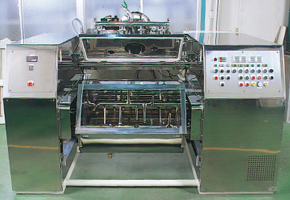
Noodle Making Machine — Vacuum Mixer
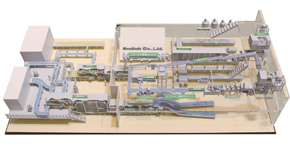
Model of an actual noodle production line
Sodick entered the food machine industry in 2007, concentrating on noodle-making machines.
Noodle-making machines’ field has recently expanded to encompass frozen noodles and cooked noodles for sale in convenience stores, from the conventional market for commercial products. Currently, Sodick offers a wide range of high-quality noodle-making products.
As noodles vary according to the season and palatability, noodle-making machines must support various types of noodles and production volumes.
For example, we currently offer noodle-making machines that allow the production on the same shared production line of udon and soba noodles, which have different boiling times and production volumes.
In particular, the CIP automatic cleaning function in the boiling tank and washing tank minimize ingress of foreign matter during the noodle production stage, which restricts bacteria and extends the use-by date. It has proven very popular for the production of noodles.
Sodick also offers a “heat recovery function” that reuses the waste heat from the discarded boiling water and the “vessel base heating function” that improves the efficiency of heat transfer. Both of these functions are used in numerous noodle production lines to save energy and improve ease of maintenance.
Sodick has developed a unique product called Mazaru which adds a liquid to containers containing one portion of noodles and then repeatedly rotates and orbits multiple containers to automatically and continuously untangle the noodles. This product has already been delivered to many customers.
Non-contact magnetic bearings manufactured by Sodick are used in the shafts that rotate the containers to enhance safety and durability.
In 2012, we were the first in Japan to receive accreditation for food machines under the international standards of the ISO 22000 Food Safety Management System in order to continue to develop and supply high-quality and highly safe products.
Entered the LED Field
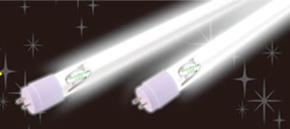
SL Series LED Lights
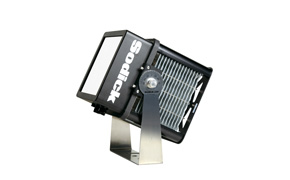
PIKA Series LED Floodlights
Sodick established Sodick LED Co., Ltd. in July 2010 to enter the field of LEDs, which are expected to reduce the energy consumption of lighting.
Of course, technologies cultivated by Sodick are applied to LEDs.
We applied novel discharge pulse control to develop the FTAC circuit as an LED power supply.
Sodick developed SL Series LED lights that are brighter than fluorescents, have ultra-long life and 60% energy savings, and are easily installed without the work required to install fluorescent lights. SL Series products are being used in workplaces around Japan.
In July 2013, we subsequently developed the PIKA Series high-intensity, single-source LED floodlights.
This floodlight is a next-generation high-intensity LED product that achieves equal or greater brightness to floodlights using conventional mercury lamps with approximately one-quarter the power consumption.
The product line-up is currently being expanded.
PIKA floodlights are being used for floodlighting in locations such as sports arenas and car parks all around Japan.
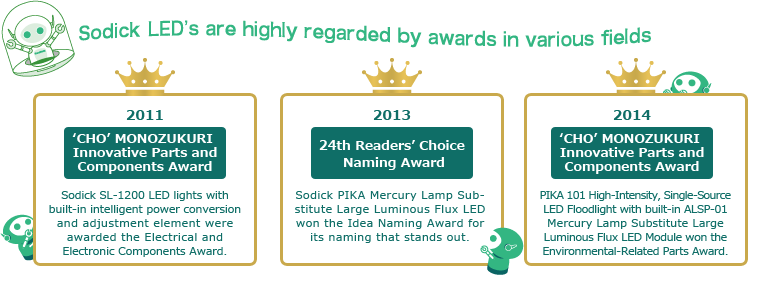

- Since the year 2000 you have made developments in various fields based on your previous developments. What direction are you aiming to move in?
-
Furukawa
It may look like we are trying out all sorts of fields but they are all an extension of our existing technologies.
Our advantage in whatever we do is the ability to make decisions quickly because we do the research in-house and are able to move quickly from one development to the next. We exploit this to keep creating more accurate products than anyone else.
- The OPM250L metal 3D printer you announced on 18 August 2014 caused a quite a stir, didn’t it?
How long have you actually been thinking about this concept? -
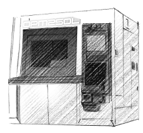 Furukawa
I was very familiar with this because the Germans were already doing it when I visited Germany when I was young.
While I’m always saying “Go for it!” for new ideas, we were busy with other developments.
Furukawa
I was very familiar with this because the Germans were already doing it when I visited Germany when I was young.
While I’m always saying “Go for it!” for new ideas, we were busy with other developments.
When we finally got the chance to tackle metal 3D printing, our engineer put their hands up to volunteer. They were able to achieve in just half a year. Just incredible.
- As the founder of the company, what are your hopes for Sodick in the future?
- Furukawa
Everyone is working very hard and have outdone themselves. All I intended to do was to develop people.
I hope that these people will further grow their pride in manufacturing and drive the company forward.
- What do you think is required to further develop Japanese manufacturing in the future?
- Furukawa
It depends on whether we insist on manufacturing in Japan or not.
Because of the shortage of workers, insisting on manufacturing in Japan would require automated production using robots and machines.
Wait and see, performances for this metal 3D printer will be quicker and easier for the time to come. I think this foundation of technological developments should remain in Japan so that it will bolster the Japanese manufacturing. Japanese manufacturing is just amazing.
Therefore, I prefer to make the metal 3D printers in Japan. Making them overseas because it costs less would mean Japanese technology disappearing.
- In March 2013 you received an honorary doctorate in recognition of your achievements. How did you feel at that time?
- Furukawa
I felt like a player selected to represent the Sodick team.
Of course I worked very hard but I think we were able to contribute to society since all our engineers and factory employees put enormous efforts into what they do every day.
 LED floodlights are also going well.
LED floodlights are also going well.
We are helping with evening sports practice for everyone from primary school children to university students and professionals. We have reduced electricity costs from about 10,000 yen an hour to just 300 yen. The high electricity cost used to mean that the lights had to go out at 9 pm and people need to quit the practices and go home. (Laughs)
A lot of people are happy with the opportunity to have convenient and low-cost training. I think it promotes sport to young people.
My dream is to hold the Tokyo Olympics with a lot of Sodick products fitted above the athletics stadium. (Laughs)
Our products are already used at the soccer training ground for the Olympics. They are also used in grounds designated by the Kanagawa Prefecture and Tokyo Metropolitan Soccer Federations.
They are second to none in terms of brightness and energy savings.








